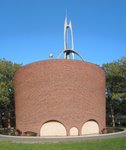Tuesdays in the Chapel
Tuesday September 27 | 8:30am | MIT Chapel
Speaker: Brian Aull, Bahá'í Chaplain, MIT
Readings:
O CHILDREN OF MEN! Know ye not why We created you all from the same dust? That no one should exalt himself over the other. Ponder at all times in your hearts how ye were created. Since We have created you all from one same substance it is incumbent on you to be even as one soul, to walk with the same feet, eat with the same mouth and dwell in the same land, that from your inmost being, by your deeds and actions, the signs of oneness and the essence of detachment may be made manifest. Such is My counsel to you, O concourse of light! Heed ye this counsel that ye may obtain the fruit of holiness from the tree of wondrous glory.
-Bahá’u’lláh
Do we not all have one father? Has not one God created us? Why do we deal treacherously each against his brother so as to profane the covenant of our fathers?
Malachi 2:10
"O Mankind, We created you from a single (pair) of a male and a female and made you into nations and tribes, that you may know each other. Verily the most honored of you in the sight of God is he who is the most righteous of you." (Quran 49:13)
Radiate boundless love towards the entire world, above, below, and across, unhindered, without ill will, without enmity. –The Buddha
And when he sees Me in all and sees all in Me, then I never leave him and he never leaves Me, and he who in this oneness of Love, Loves Me in whatever he sees, wherever this man may live, in truth he lives in Me. –Bhagavad Gita
Talk (listen here):
Saint Andrew the Apostle Catholic Church stands on the corner of 38th Street and Forest Manor Drive on the northeast side of Indianapolis. Attached to the church is the elementary school that I attended in the 1960s. From my home on Devon Lake, it was just shy of a 1-mile walk or bike ride to get to school or to Sunday Mass. At the time, the neighborhoods traversed in that journey were overwhelmingly white and upper middle class. If you drove south from the church a few blocks, the character of the neighborhood changed suddenly when you crossed a certain street. You were now in a predominately black neighborhood. As a white person, even in the safety of a passing car, I found the transition was accompanied by a sense of unease.
At one point, a plan was announced for the building of a Baptist church on the corner opposite Saint Andrew, a predominately black congregation. Someone circulated a petition seeking to stop this, claiming that the new church would create parking and traffic problems. My Uncle Francis, who lived just down the street, said that he “smelled a rat.” My elders all recognized the racial motivation behind the petition, and condemned it.
On the other hand, there were no black people in my family’s social circle. I lived in a sort of bubble. Thinking about the segregated neighborhoods we lived in recalls to mind Martin Luther King’s statement: "Men often hate each other because they fear each other; they fear each other because they don't know each other; they don't know each other because they cannot communicate; they cannot communicate because they are separated."
As the years went by, the demarcation line moved steadily northward, and there was “white flight” to suburbs farther north. There were economic motives, of course, but also it’s human nature to flee the unfamiliar, to fear what we don’t understand.
When I grew up, I had opportunities to escape the bubble. Going to school in Cambridge, Massachusetts, I met students and scholars from all over the world. Then I met my wife, who is the daughter of a marriage between an African American man and a white woman. Now I had black people who were part of my extended family. My own son and daughter are descendants of African slaves. In recent years, I became involved in reaching out to families, mostly Haitian immigrants, who live in low-income housing projects in Cambridge. I’ve conducted classes on virtues and spirituality for their children. Now I comfortably visit the parents or attend a child’s birthday party. Growing up in Indianapolis, it would have been inconceivable to go down to 23rd street and visit a black family.
From inside the bubble, it felt like a warm and protective shelter. From outside the bubble, I recognize it as a prison. Many of the fears I had were based on superstition. Being human, I still have many kinds of prejudice and bias; there’s always more progress to make, larger bubbles to escape.
In 2014, I returned to Indianapolis for a weekend to attend the first ever reunion of my grade school class. A number of the classmates attended Sunday Mass. The neighborhood population is now nearly 90% black, so I went there expecting to see an overwhelmingly black congregation. Instead, I saw a diverse one, blacks and whites celebrating the Mass together and working together on outreach service projects in the neighborhood. There were some whites that had refused the path of “white flight” and others who continued to attend the church after moving out of the parish. In a society where churches have been among the most segregated institutions, this is a worthy accomplishment and shows that racial alienation is not destiny. How we deal with diversity and difference is, in the final analysis, a choice.
News from MIT's Chaplain to the Institute
